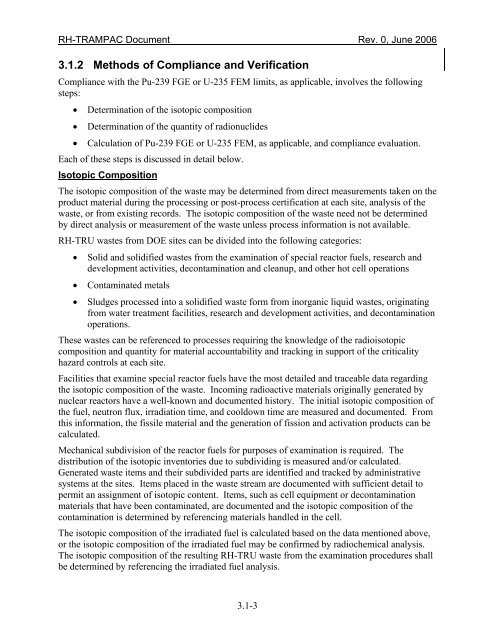RH-TRAMPAC - Waste Isolation Pilot Plant - U.S. Department of ...
RH-TRAMPAC - Waste Isolation Pilot Plant - U.S. Department of ...
RH-TRAMPAC - Waste Isolation Pilot Plant - U.S. Department of ...
You also want an ePaper? Increase the reach of your titles
YUMPU automatically turns print PDFs into web optimized ePapers that Google loves.
<strong>RH</strong>-<strong>TRAMPAC</strong> Document Rev. 0, June 20063.1.2 Methods <strong>of</strong> Compliance and VerificationCompliance with the Pu-239 FGE or U-235 FEM limits, as applicable, involves the followingsteps:• Determination <strong>of</strong> the isotopic composition• Determination <strong>of</strong> the quantity <strong>of</strong> radionuclides• Calculation <strong>of</strong> Pu-239 FGE or U-235 FEM, as applicable, and compliance evaluation.Each <strong>of</strong> these steps is discussed in detail below.Isotopic CompositionThe isotopic composition <strong>of</strong> the waste may be determined from direct measurements taken on theproduct material during the processing or post-process certification at each site, analysis <strong>of</strong> thewaste, or from existing records. The isotopic composition <strong>of</strong> the waste need not be determinedby direct analysis or measurement <strong>of</strong> the waste unless process information is not available.<strong>RH</strong>-TRU wastes from DOE sites can be divided into the following categories:• Solid and solidified wastes from the examination <strong>of</strong> special reactor fuels, research anddevelopment activities, decontamination and cleanup, and other hot cell operations• Contaminated metals• Sludges processed into a solidified waste form from inorganic liquid wastes, originatingfrom water treatment facilities, research and development activities, and decontaminationoperations.These wastes can be referenced to processes requiring the knowledge <strong>of</strong> the radioisotopiccomposition and quantity for material accountability and tracking in support <strong>of</strong> the criticalityhazard controls at each site.Facilities that examine special reactor fuels have the most detailed and traceable data regardingthe isotopic composition <strong>of</strong> the waste. Incoming radioactive materials originally generated bynuclear reactors have a well-known and documented history. The initial isotopic composition <strong>of</strong>the fuel, neutron flux, irradiation time, and cooldown time are measured and documented. Fromthis information, the fissile material and the generation <strong>of</strong> fission and activation products can becalculated.Mechanical subdivision <strong>of</strong> the reactor fuels for purposes <strong>of</strong> examination is required. Thedistribution <strong>of</strong> the isotopic inventories due to subdividing is measured and/or calculated.Generated waste items and their subdivided parts are identified and tracked by administrativesystems at the sites. Items placed in the waste stream are documented with sufficient detail topermit an assignment <strong>of</strong> isotopic content. Items, such as cell equipment or decontaminationmaterials that have been contaminated, are documented and the isotopic composition <strong>of</strong> thecontamination is determined by referencing materials handled in the cell.The isotopic composition <strong>of</strong> the irradiated fuel is calculated based on the data mentioned above,or the isotopic composition <strong>of</strong> the irradiated fuel may be confirmed by radiochemical analysis.The isotopic composition <strong>of</strong> the resulting <strong>RH</strong>-TRU waste from the examination procedures shallbe determined by referencing the irradiated fuel analysis.3.1-3
















